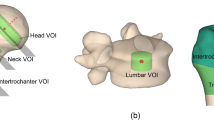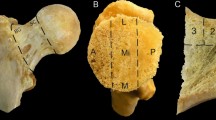Abstract:
It has been shown previously that the antero-inferior cortex is subjected to maximal tensile stress during a fall onto the greater trochanter. We have recently shown that in cases of femoral neck fracture, cortical thinning and porosity is greatest in the anterior and antero-inferior region of the femoral neck. To investigate whether this is due to increased remodeling, we have quantified surface-based parameters associated with Haversian remodeling in femoral neck biopsies from women with intracapsular hip fracture and post-mortem controls. Cryostat sections of chilled biopsies were reacted for either tartrate-resistant acid phosphatase (TRAP) or alkaline phosphatase (ALP) activity. Proportions of active canals were determined in each quadrant (inferior, anterior, superior, posterior) of the femoral neck. The biopsies were then embedded in methacrylate to permit histomorphometry using Goldner’s and Solochrome sections. In the cases there was no significant increase in the proportion of canals undergoing remodeling in the cortex as a whole (p = 0.846), but the regional distribution of remodeling was markedly different from that in the controls. In the anterior cortex, the proportion of canals undergoing remodeling was increased by 56% (p = 0.0087); in contrast there was a relative decrease of 35% in the superior region (p = 0.0047). In the anterior cortex of cases there were 76% and 42% increases in the proportions of eroded (p = 0.019) and osteoid-bearing (p = 0.041) canals, respectively. In the superior region, the decrease in the proportion of remodeling sites was due to a marked decrease in canals with an osteoid surface (51%; p = 0.0031). Covariance analysis with cortical porosity as the dependent variable showed that porosity was significantly dependent on the regional distribution of eroded (p = 0.033) but not on the distribution of forming (p = 0.153) canals (R 2adj = 0.51). Cellular levels of TRAP and ALP were significantly elevated in the anterior region of cases compared with the controls (TRAP 55%, p = 0.006; ALP 36%, p = 0.003). For the posterior and inferior regions there were no marked differences in cellular TRAP and ALP levels compared with control values. These data show that the increased cortical thinning and increased porosity we have previously observed in the anterior cortex in cases of hip fracture are associated with increased indices of Haversian remodeling. These findings are consistent with the hypothesis that, in cases of hip fracture, remodeling imbalance in the anterior cortex is a continuing process up to the time of fracture and is due to increased osteoclastic cellular activity associated with an osteoblastic response that is inadequate to prevent bone loss.
Similar content being viewed by others
Author information
Authors and Affiliations
Additional information
Received: 16 November 1998 / Accepted: 17 February 1999
Rights and permissions
About this article
Cite this article
Bell, K., Loveridge, N., Power, J. et al. Intracapsular Hip Fracture: Increased Cortical Remodeling in the Thinned and Porous Anterior Region of the Femoral Neck . Osteoporos Int 10, 248–257 (1999). https://doi.org/10.1007/s001980050223
Issue Date:
DOI: https://doi.org/10.1007/s001980050223




